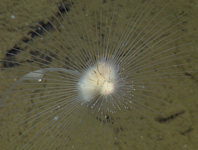Abstract
We re-examined the type series of Rana conspicillata Günther, 1872 from Matang in western Sarawak, Borneo and found it to consist of specimens of three distinct species that can be separated by qualitative morphological characters and morphometrics. We re-allocate one paralectotype to Limnonectes hikidai and another to a large-sized species from western Borneo that we describe as new. The new species is morphologically distinguished from all described species of the L. kuhlii group from the Sunda region by body size, extent of toe webbing, head size and odontoid shape. It differs genetically from all described species for which genetic information is available. In order to facilitate the further taxonomic revision of the L. kuhlii group on Borneo, we provide a detailed morphological redescription of the holotype of Rana conspicillata.
References
Boulenger, G.A. (1920) A monograph of the South Asian, Papuan, Melanesian and Australian frogs of the genus Rana. Records of the Indian Musuem, 20, 1–223.
https://doi.org/10.5962/bhl.title.12471Dehling, J.M. (2014) Eine neue Fangzahnfroschart der Gattung Limnonectes (Anura: Dicroglossidae) vom Gunung Lawit, Malaiische Halbinsel / A new species of fanged frog of the genus Limnonectes (Anura: Dicroglossidae) from Gunung Lawit, Peninsular Malaysia. Sauria, 36, 17–30.
Dehling, J.M. (2015) On the identities of two enigmatic reed frog taxa from South Sudan, Rappia papyri Werner, 1908 and Rappia pachyderma Werner, 1908 (Anura: Hyperoliidae). Herpetozoa, 28, 39–47.
Günther, A. (1872) On the reptiles and amphibians of Borneo. Proceedings of the Zoological Society of London, 1872, 586–600, pls. xxxv–xl.
Günther, A.C.L.G. (1874) Reptilia (1872). Zoological Record, 9, 61–81.
Inger, R.F. (1966) The systematics and zoogeography of the Amphibia of Borneo. Fieldiana: Zoology, 52, 1–402.
Inger, R.F., Boeadi & Taufik, A. (1996) New species of ranid frogs (Amphibia: Anura) from Central Kalimantan, Borneo. The Raffles Bulletin of Zoology, 44, 363–369.
Inger, R.F. Stuebing, R.B., Grafe, T.U. & Dehling, J.M. (2017) A field guide to the frogs of Borneo. 3rd Edition. Natural History Publications (Borneo), Kota Kinabalu, viii + 232 pp.
Kumar, S., Stecher, G. & Tamura, K. (2016) MEGA7: Molecular evolutionary genetics analysis version 7.0 for bigger datasets. Molecular Biology and Evolution, 33, 1870–1874.
https://doi.org/10.1093/molbev/msw054Manthey, U. & Grossmann, W. (1997) Amphibien & Reptilien Südostasiens. Natur und Tier Verlag, Münster, 512 pp.
Matsui, M. (2015) A new species of Limnonectes from the border of East Kalimantan and Sarawak, Borneo Island (Anura, Dicroglossidae). Current Herpetology, 34, 120–127.
https://doi.org/10.5358/hsj.34.120Matsui, M. & Nishikawa, K. (2014) Description of a new species of Limnonectes from Sarawak, Malaysian Borneo (Dicroglossidae, Anura). Current Herpetology, 33, 135–147.
https://doi.org/10.5358/hsj.33.135Matsui, M., Kuraishi, N., Jiang, J.-P., Ota, H., Hamidy, A., Orlov, N.L. & Nishikawa, K. (2010a) Systematic reassessments of fanged frogs from China and adjacent regions (Anura: Dicroglossidae). Zootaxa, 2345, 33–42.
Matsui, M., Panha, S., Khonsue, W. & Kuraishi, N. (2010b) Two new species of the “kuhlii” complex of the genus Limnonectes from Thailand (Anura: Dicroglossidae). Zootaxa, 2615, 1–22.
Matsui, M., Dubois, A. & Ohler, A. (2013) New replacement name for Rana paradoxa Mocquard, 1890 with designations of lectotypes for Rana paradoxa and Rana conspicillata Günther, 1872: both synonymized with Limnonectes kuhlii (Tschudi, 1838) (Dicroglossidae: Dicroglossinae). Asian Herpetological Research, 4 (3), 187–189.
Matsui, M., Belabut, D.M. & Ahmad, N. (2014a) Two new species of fanged frogs from Peninsular Malaysia (Anura: Dicroglossidae). Zootaxa, 3881 (1), 75–93.
https://doi.org/10.11646/zootaxa.3881.1.6Matsui, M., Nishikawa, K. & Eto, K. (2014b) A new burrow-utilising fanged frog from Sarawak, East Malaysia (Anura: Dicroglossidae). The Raffles Bulletin of Zoology, 62, 679–687.
Matsui, M., Kuraishi, N., Eto, K., Hamidy, A., Nishikawa, K., Shimada, T., Yambun, P., Vairappan, C.S. & Hossman, M.Y.B. (2016) Unusually high genetic diversity in the Bornean Limnonectes kuhlii-like fanged frogs (Anura: Dicroglossidae). Molecular Phylogenetics and Evolution, 102, 305–319.
https://doi.org/10.1016/j.ympev.2016.06.009McLeod, D.S. (2008) A new species of big-headed, fanged dicroglossine frog (genus Limnonectes) from Thailand. Zootaxa, 1807, 26–46.
McLeod, D.S. (2010) Of least concern? Systematics of a cryptic species complex: Limnonectes kuhlii (Amphibia: Anura: Dicroglossidae). Molecular Phylogenetics and Evolution, 56, 991–1000.
https://doi.org/10.1016/j.ympev.2010.04.004McLeod, D.S., Horner, S.J., Husted, C., Barley, A. & Iskandar, D. (2011) “Same-same, but different”: an unusual new species of the Limnonectes kuhlii complex from West Sumatra (Anura: Dicroglossidae). Zootaxa, 2883, 52–64.
McLeod, D.S., Kelly, J.K. & Barley, A. (2012) “Same-same, but different”: Another new species of the Limnonectes kuhlii complex from Thailand (Anura: Dicroglossidae). Russian Journal of Herpetology, 19, 261–274.
Ohler, A. & Deuti, K. (2013) Pyxicephalus khasianus Anderson, 1871 and Rana laticeps Boulenger, 1882 (Dicroglossidae, Anura, Amphibia) are synonyms. Zoosystema, 35, 415–424.
https://doi.org/10.5252/z2013n3a4Palumbi, S.R. (1996) Nucleic acids II: the polymerase chain reaction. In: Hillis, D.M., Moritz, C. & Mable, B.K. (Eds.), Molecular Systematics. Sinauer Associates, Inc., Sunderland, pp. 205–247.
Palumbi, S., Martin, A., Romano, S., McMillan, W.O., Stice, L. & Grabowski, G. (1991) The Simple Fool’s Guide to PCR. Version 2. University of Hawaii, Honolulu, Hawaii, 46 pp.
Suwannapoom, C., Yuan, Z.-Y., Chen, J.-M., Hou, M., Zhao, H.-P., Wang, L.-J., Nguyen, T.S., Nguyen, T.Q., Murphy, R.W., Sullivan, J., McLeod, D.S. & Che, J. (2016) Taxonomic revision of the Chinese (Anura, Dicroglossidae) with the description of a new species from China and Myanmar. Zootaxa, 4093 (2), 181–200.
https://doi.org/10.11646/zootaxa.4093.2.2Taylor, E.H. (1962) The amphibian fauna of Thailand. The University of Kansas Science Bulletin, 43, 265–599.
https://doi.org/10.5962/bhl.part.13347Voris, H.K. (2000) Maps of Pleistocene sea levels in Southeast Asia: shorelines, river systems and time durations. Journal of Biogeography, 27, 1153–1167.
https://doi.org/10.1046/j.1365-2699.2000.00489.xWells, K.D. (2007) The ecology and behavior of amphibians. The University of Chicago Press, Chicago, 1400 pp.

